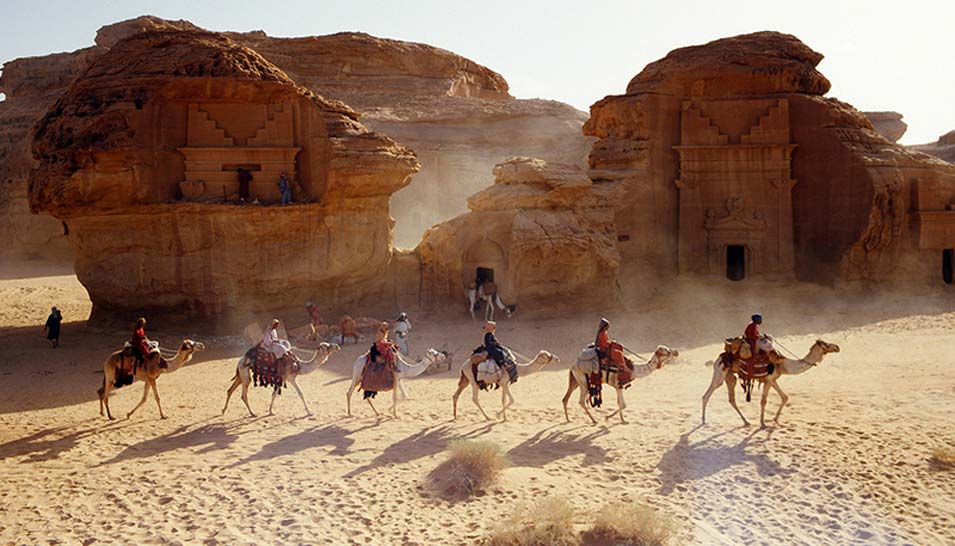Early arabia
Of all the empires that profited from the lucrative trade in frankincense, few have captured the imagination like the Nabataeans, a people of Bedouin origin who developed a specialised knowledge of the trade caravan routes.From their extraordinary rock-hewn cities of Madain Saleh and Petra (in Jordan), the Nabataeans grew wealthy from around 200 BC by exacting tolls and protection money from the caravans. The Nabataeans never really possessed an ‘empire’ in the common military and administrative sense of the word, but instead established a zone of influence that stretched as far north as Syria and south into the Hadramawt (Yemen).
In the years following the Prophet Mohammed’s death in AD 632, the territory of what is now Saudi Arabia was nominally ruled from afar by the Umayyad and Abbasid caliphates, and was saved from obscurity only by the spiritual significance of the holy cities of Mecca and Medina.
By 1517 the Ottomans, under Salim I, had established their authority over Hejaz, a deeply unpopular move in Arabia.
Birth of saudi arabia
In 1703 Mohammed ibn Abd al-Wahhab was born in the oasis of Al-Uyaynah in the Najd. After a period of itinerant religious scholarship, Al-Wahhab returned to Al-Uyaynah to preach a zealous message calling for the purification of Islam.Al-Wahhab’s reformist zeal was initially tolerated by the local authorities, but he was expelled from the town after he meted out severe punishments to those who didn’t engage in communal prayer, and led the stoning of a woman accused of adultery. He sought refuge in Dir’aiyah, 65km from Al-Uyaynah, where he was granted protection by Mohammed ibn al-Saud, the local emir.
In the meantime, there was considerable anger throughout Arabia that the holy cities of Mecca and Medina were under foreign (Ottoman) tutelage and the Saudi-Wahhabi emirate expanded rapidly.
Upon his death, Al-Saud was succeeded by his son Abdul Aziz, who captured Riyadh in 1765. In 1792 Al-Wahhab died but the inexorable expansion of the Saudi-Wahhabi emirate continued.
In 1803 the Saudi army marched on the Hejaz and defeated Sherif Hussain of Mecca. The same year, Abdul Aziz was assassinated by a Shiite fanatic in the mosque of Dir’aiyah in revenge for the Saudi- Wahhabi sacking of the Shiite cities of Iraq. Despite losing their leader, the Saudi-Wahhabi emirate was recognised by the Mecca authorities. The first Saudi empire stretched from Al-Hasa in the east to Hejaz in the west and to Najran in the south.
Second saudi empire
It didn’t last long. The Ottoman Sultan Mahmoud II ordered his viceroy in Egypt, Mohammed Ali, to retake Hejaz in the Ottoman sultan’s name. With the support of many Arabian tribes who resented the strictures of Saudi-Wahhabi rule, the Ottoman armies took Mecca and Medina in 1814, conquered the Saudi-Wahhabi stronghold of Dir’aiyah on 11 September 1818 and executed Abdullah ibn al-Saud (Abdul Aziz’s successor).In 1824 Turki ibn Abdullah, the son of the executed Abdullah, retook Riyadh. A series of assassinations and family squabbles over succession attracted the attention of the Ottomans, who captured Faisal, the emir of Riyadh, and sent him into exile in Cairo. Six years later, Faisal escaped, marched on Riyadh and regained the throne, a position he would hold for another 22 years. After Faisal died, Riyadh fell to the Al-Rashids, an increasingly powerful tribe based around Hail, in the early 1890s.
The decisive battle for the future of Arabia came in 1902 when the 21-year-old Abdul Aziz ibn Abdul Rahman ibn al-Saud (Ibn Saud) and a small band of followers stormed Riyadh at night. The religious authorities in Riyadh then swore allegiance to the Al-Sauds through a series of religious edicts.
With deft diplomacy skills and the momentum of successful military campaigns, Ibn Saud orchestrated a conference at which Arabia’s Islamic clergy condemned Sherif Hussain (ruler of Mecca) as a foreign puppet. Although Sherif Hussain responded by proclaiming himself the King of the Arabs, the tide of history was with Ibn Saud.
In 1925 the Saudi-Wahhabi alliance took Mecca and Medina. The following year Ibn Saud proclaimed himself King of the Hejaz and Sultan of Najd, and on 22 September 1932, Ibn Saud announced the formation of the Kingdom of Saudi Arabia.
Discovery of oil
The economic future of the new kingdom was almost instantly secured with the discovery of oil and the signing in 1933 of Saudi Arabia’s first oil concession. Four years later, the Arabian American Oil Company (Aramco) discovered commercial quantities of oil near Riyadh and in the area around Dammam in the east. In 1943 President Roosevelt established the Kingdom’s political importance by stating grandly that the Kingdom was ‘vital for the defence of the USA’.Upon Ibn Saud’s death on 9 November 1953, his profligate son Saud became king. Saud endeared himself to the Arab in the street by supporting Egypt in the Suez Crisis of 1956, but, with the Kingdom’s finances in deep trouble, Saud abdicated in 1964.
His brother Faisal proved more willing to provide his citizens with a stake in the economic benefits of oil. He introduced, among other things, a free health service for all Saudis, and began the building boom that has transformed Saudi Arabia from an impoverished desert kingdom into a nation of modern infrastructure.
In response to the USA’s unconditional support for Israel, Saudi Arabia imposed an oil embargo on the USA in 1974, a move that quadrupled world oil prices, drew support from across the region and reminded the world of Saudi Arabia’s importance in a world economy dependent upon oil.
Growing pains
On 25 March 1975 King Faisal was assassinated by a nephew. Although the throne passed to Faisal’s brother Khaled, a man who was known for his piety, frugal lifestyle and closeness to his subjects, the real power behind the throne was another of Faisal’s brothers, Fahd.In November 1979 the Great Mosque of Mecca was overrun by 250 fanatical followers of Juhaiman ibn Saif al-Otai, a militant Wahhabi leader, who claimed that the Mahdi (Messiah) would appear in the mosque on that very day. During two bloody weeks of fighting, 129 people were killed. The conflict was a devastating blow to the credibility of a regime that had prided itself on being the inheritors of the Wahhabi legacy and the rulers best able to safeguard the holy places.
During the following year, riots also broke out in the towns of the Qatif Oasis, the heartland of the Kingdom’s 300, 000 Shiites, many of whom were inspired by the revolutionary fervour of their co-religionists in Iran and the exhortations of the Ayatollah Khomeini to export the Shiite revolution. The riots were brutally put down.
On 14 June 1982 the figurehead King Khaled died aged 69. Fahd became king and set about reinforcing the twin pillars (and contradictions) of modern Al-Saud rule. He made a priority of proving himself a moderate and reliable friend of the West, while in 1986 he proclaimed himself the ‘Custodian of the Two Holy Mosques’.
Saudi arabia today
When Iraq invaded Kuwait in August 1990, Saudi Arabia’s subsequent decision to allow foreign military forces to operate from Saudi soil would later prove one of the catalysts for propelling Osama bin Laden, a Saudi, and his Al-Qaeda movement onto the world stage.In 1991 a petition calling for reforms and greater openness was sent to King Fahd by liberal intellectuals. It was quickly followed by a contrary petition by conservative Islamic scholars – a struggle symbolic of the two opposing sides of Saudi politics that continues to this day.
After a great deal of fanfare, the much-vaunted Consultative Council (Majlis ash-Shoura) was opened on 20 August 1993.
When Fahd died from a stroke in August 2005, his half-brother Abdullah ascended to the throne. Prince Sultan bin Abdulaziz al-Saud became crown prince.
An uncertain future
After the terrorist attacks on New York and Washington on 11 September 2001, and the discovery that 15 of the accused 19 hijackers were Saudi citizens, the world’s attention focussed on Saudi Arabia. Western governments questioned both the alleged financing of terrorists in the Kingdom and the measures taken by the authorities to combat Al-Qaeda cells operating there.In 2003 and 2004, a series of widely reported Al-Qaeda terrorist attacks targeted Westerners in Riyadh, Al-Khobar and Yanbu. It led to the subsequent departure of an estimated 50% of expat Americans and 30% of Europeans (on whom the government is so dependent for technical expertise). As a result, the Saudi authorities have been very keen to be seen to combat terrorism, including the hunting down of its main operatives.
However, for as long as security (in the shape of international terrorism) and economic issues (in the shape of oil) remain a key concern for Washington, Saudi Arabia will remain a vital strategic partner to the USA and the West.
For the Kingdom’s part, it has to play a difficult double-game. On the one hand, it’s keen to show itself as a staunch supporter of the West and its ‘War on Terror’ (and in doing so, continue to benefit from the trade it depends upon). On the other, it has to try and allay the growing resentment and hostility of its own people and religious establishment (who see the war in Iraq as unjustified and disastrous), and the insidious, corrupting influence of the West in general.
Saudi Arabia also fears a power imbalance in the region, so is strongly opposed to the withdrawal of US troops from Iraq. Nervous about Shiite Iran increasing its influence in the area (with neither Iraq nor America to counter it), it also fears the stirring up of sectarian tension within its own boundaries (Shiites dominate some areas, including the eastern provinces).
In the meantime, regional, tribal and sectarian discontent continues to simmer (albeit on a low flame and generally unfelt and unheard by the traveller – it’s almost never reported by the country’s press), as does the jockeying for power among the royal family, and an increasingly restless youth.
In response, the government continues its tried-and-tested policy of dampening the flames of any political discontent by chucking lots of money at it; a criticism long levied at the Al-Sauds by their opponents – in effect buying rather than earning the loyalty of its regions and tribes.
Another persistent threat to Saudi’s future is terrorist attacks on both Western expats and the government, with the aim of destabilising what is viewed by Islamists as a corrupt and overtly pro-Western state. The security services have claimed both diligence and success in tracking down operatives. As you travel around the Kingdom, look out for the billboards proclaiming ‘Together Against Terrorism’ and ‘Help police route out these people’.
It’s worth remembering that tribal warfare and anarchy existed within the lifetime of some of the Kingdom’s inhabitants. In many respects, Saudi Arabia has achieved an enormous amount (stability, peace and modernisation) in the space of about 50 years, when it took the West centuries.






No comments: